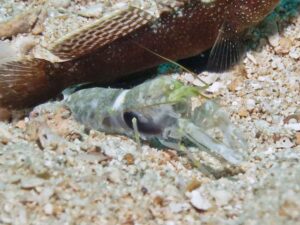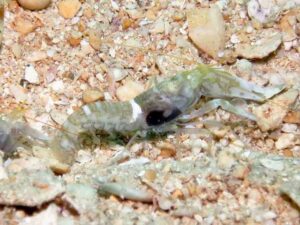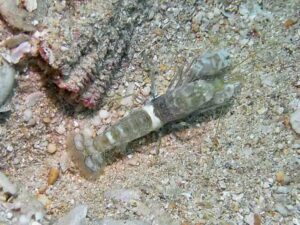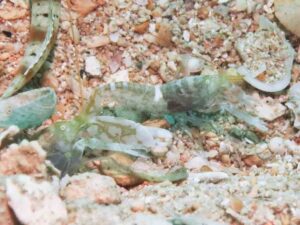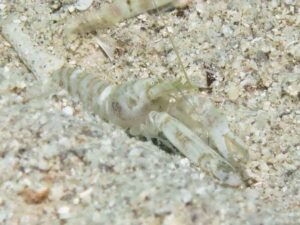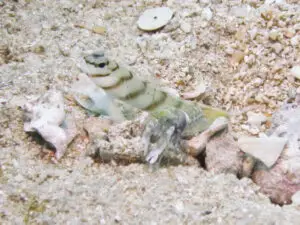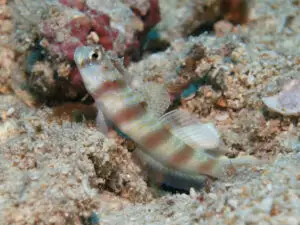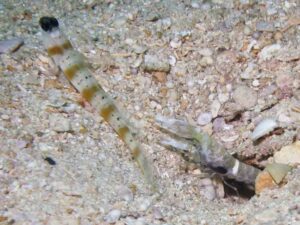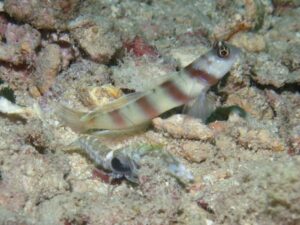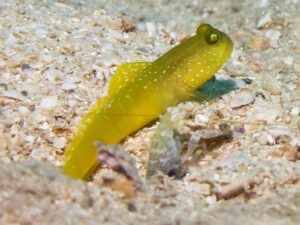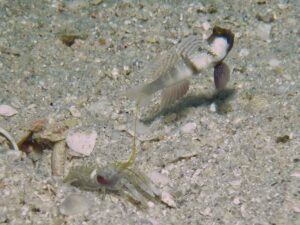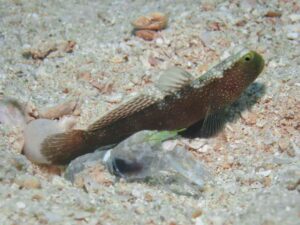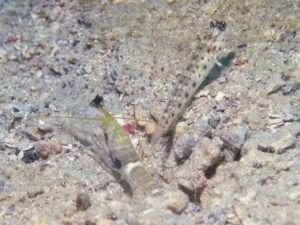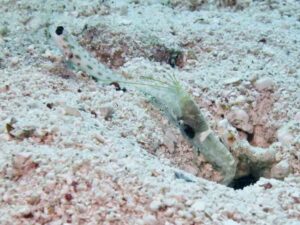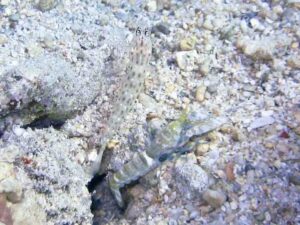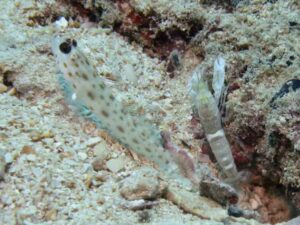Black-sided Snapping Shrimp
Alpheus djeddensis complex
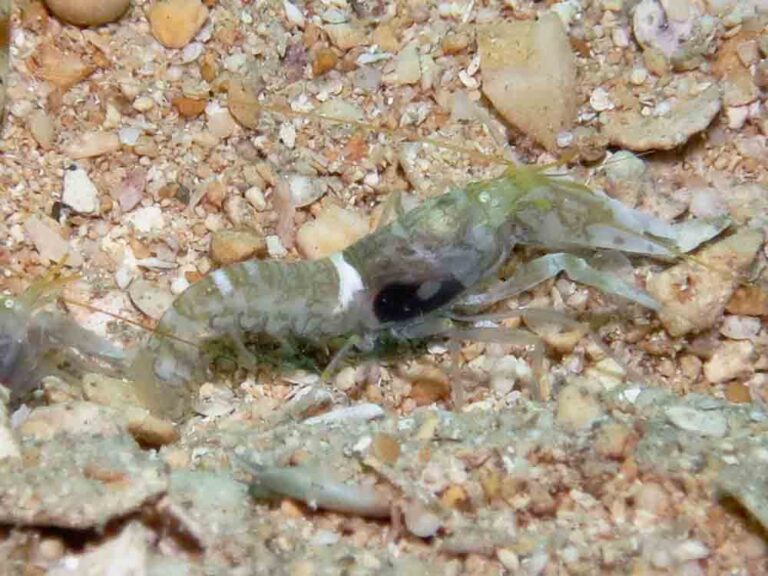
Black-sided Snapping Shrimp
Alpheus djeddensis complex
undescribed
Description
Carapace: Pale with green marbling. Viewed from above this takes the form of alternating pale and dark zones. Some have a crescent mark originating in one pale zone and terminating in a pale patch laterally. Viewed from the side there is a circumscribed black patch with a characteristic shape like an oval with a small circle cut out of the upper edge.
Abdomen: The green marbled pattern is continued. White bands are usual on segments 1 and 4, with fainter bands on the other segments.
The rostrum is bright yellow-green as are the antennae.
The pincers are pale grey and marked with a loose green network.
The chelate second legs are grey-green.
The walking legs are green with paler joints
The tail fan is olive green with pale grey scutes outlined in dark green.
The characteristically shaped black patch on the side of the carapace of this pale green shrimp is diagnostic. It is an oval with a small circle cut out of it. The defect is not in the position of the epaulette.
Similar Shrimps
The Dark Marbled Shrimp can look similar, particularly with respect to its distinctive black patch on the carapace. Both species have a defect in the superior aspect of this but in the Dark Marbled Shrimp it is caused by the epaulette mark and in the Black-sided Shrimp the hole in the patch is well away from this region.
The Black-sided Shrimp is paler overall and the carapace markings are much less distinct.
Nomenclature
The scientific name Alpheus djeddensis Coutiere 1897 has been applied to this species.
Anker (2010) Considers A. djeddensis/djiboutensis to be a species complex of four species. The status of the name Alpheus djeddensis – djiboutensis is questionable. (Miya in Bruce 1994).
Debelius (2001) Crustacea p150 has images of a similar-looking shrimp and gives the name Alpheus djeddensis with the common name Djeddah Snapping Shrimp. Length 3 to 4 cm, max 5 cm. Distribution Probably the entire Indo-West Pacific from the Red Sea to Australia and the Solomon Islands.
Hayashi & Shiratori (2003) Alpheus djeddensis from Japan.
Alternate names: Yellow-spot Goby-shrimp, Kuiter and Debelius (2009), Djeddah Snapping Shrimp Debelius (2001) assuming this identification of this shrimp is correct.
Ecology
HABITAT
Preferred substrate Coarse sand with pebbles, shell and coral debris
Depth range Shallow water to less than 20 metres. In areas of clean water with good water movement. The back slope of outer reefs on the northern Great Barrier Reef.
Proximity to reef Burrows are constructed close to the base of the reef and out into sandy channels.
NATURAL HISTORY
An adaptable species that forms an association with at least nine shrimpgoby species. Forages locally for scraps of vegetable matter. We have seen and recorded on video a female laden with eggs working along with the male excavating a channel near the burrow entrance. Aquarium observations suggest that the laden female normally stays within an inner chamber until the eggs hatch.
Distribution
Published distribution: Probably the entire Indo-West Pacific from the Red Sea to Australia and the Solomon Islands Debelius (2001). Bali, Indonesia, Kuiter and Debelius (2009).
Our records: Australia; Lizard Island, Flynn Reef, Norman Reef, St Crispin Reef, Ribbon Reefs 3 & 10.
Solomon Islands; Ghizo, Kolombangara Island, Maravagi, Russell Islands, Soghonangola Island.
Papua New Guinea; Hermit Islands, Kimbe Bay in New Britain
Associated Goby species
Associated Shrimpgobies (eight species)
Amblyeleotris guttata, Blackchest Shrimpgoby
Amblyeleotris gymnocephala, Mask Shrimpgoby
Amblyeleotris ogasawarensis, Redspotted Shrimpgoby
Amblyeleotris periophthalma, Broadbanded Shrimpgoby
Amblyeleotris steinitzi, Steinitz’s Shrimpgoby
Ctenogobiops crocineus, Silverspot Shrimpgoby
Ctenogobiops pomastictus, Goldspeckled Shrimpgoby
Tomiyamichthys nudus, Scaleless Shrimpgoby
Video
A pair of Brown Pyjama Shrimp bulldozing a channel out from the entrance of the burrow. (to be added later)

